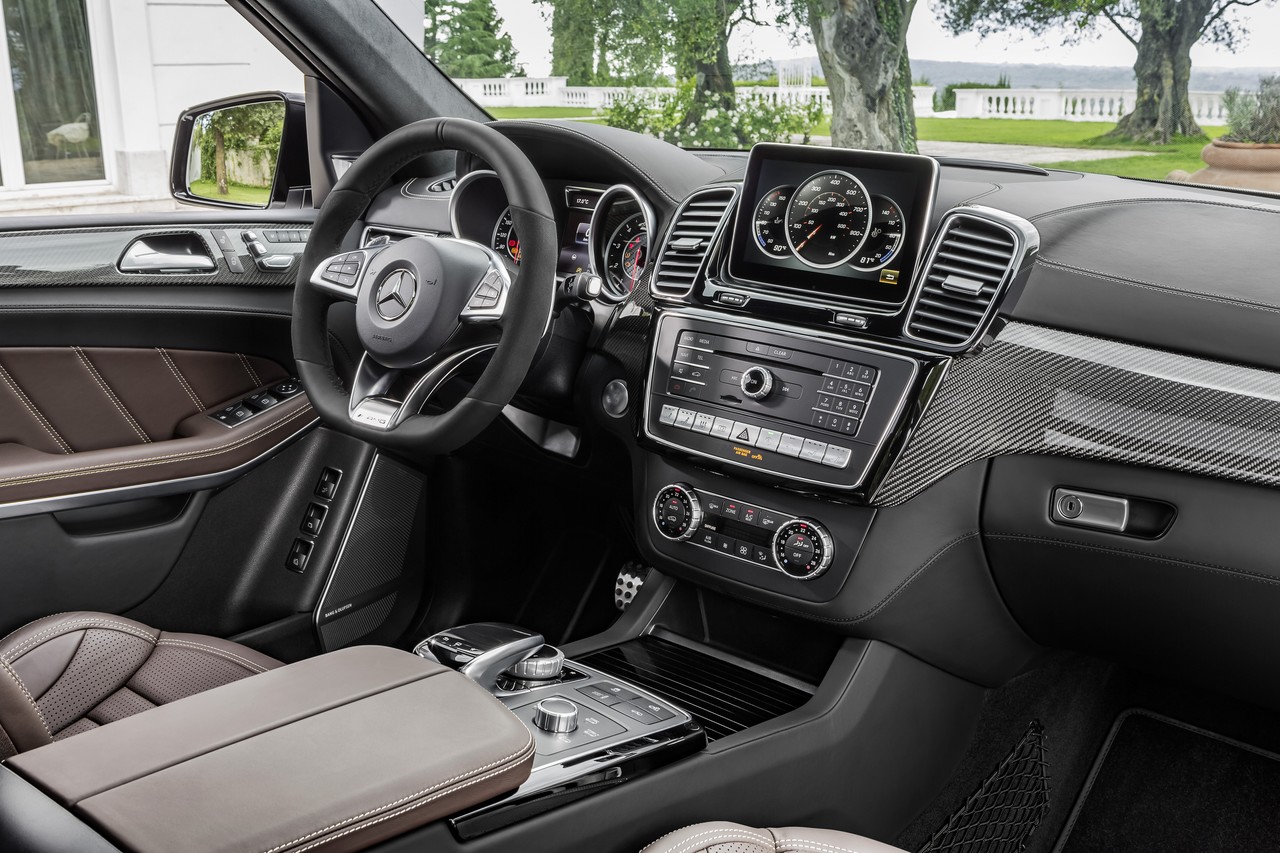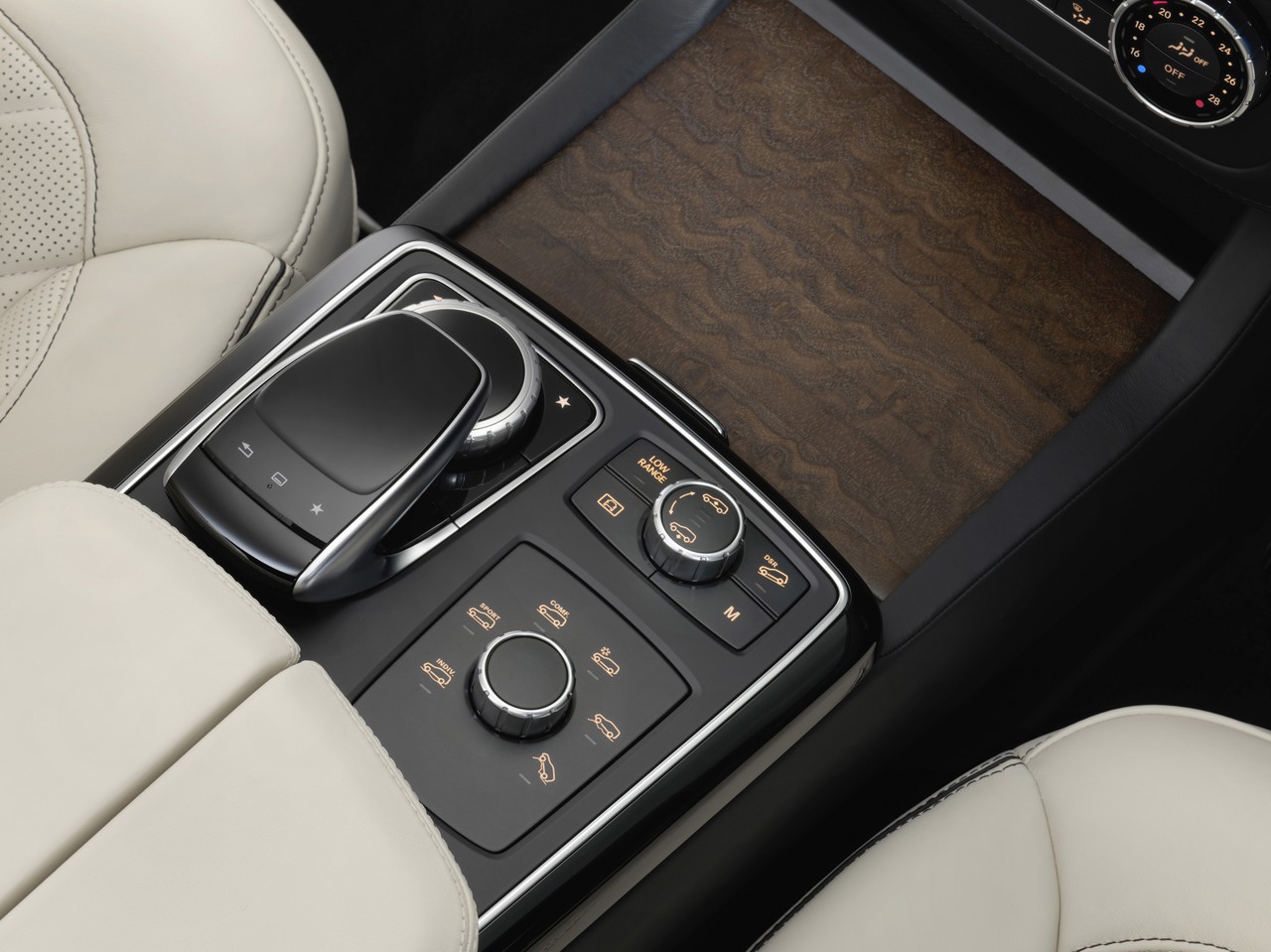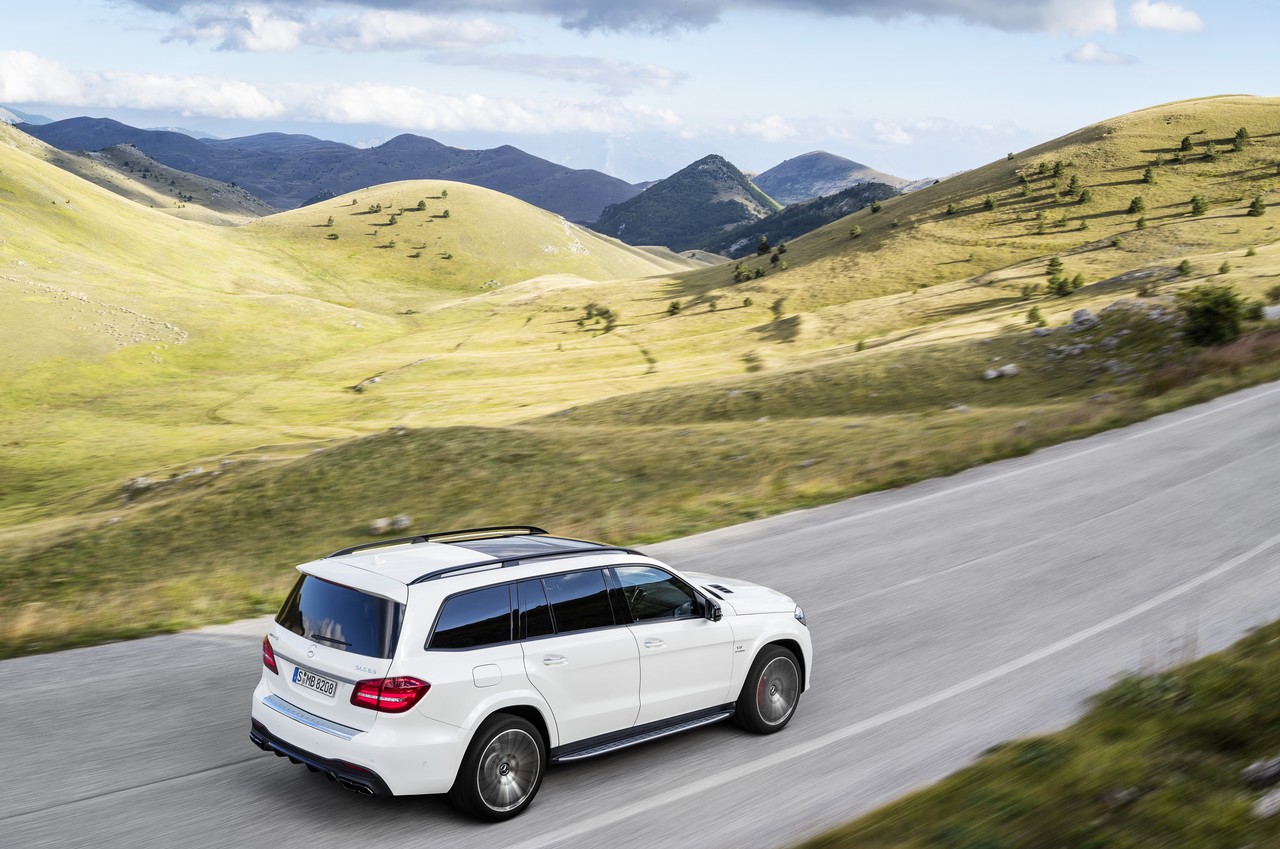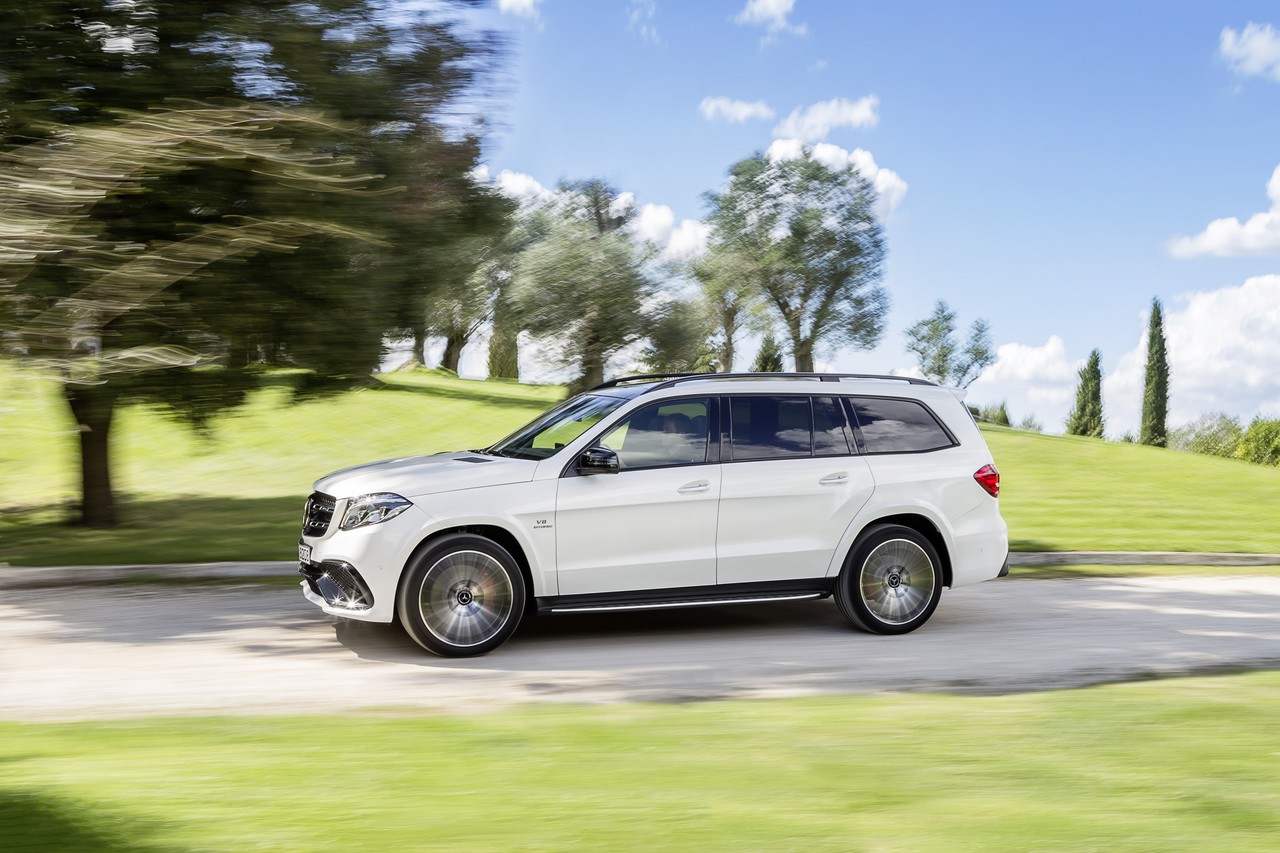
- Powerful 5.5-litre biturbo M157 V8 engine
- Capable dynamics
- Supportive front seats
- Spacious and comfortable interior
- Weight blunts agility
- High running and maintenance costs
Overview
Released in Australia in April 2016, the Mercedes-AMG X166 GLS 63 was a seven-seat, four-wheel drive wagon. Manufactured in Tuscaloosa, USA, the Mercedes-AMG GLS 63 was powered by a 5.5-litre biturbo V8 petrol engine that was mated to a seven-speed automatic transmission.
Due to a change in naming conventions, the Mercedes-AMG X166 GLS 63 AMG effectively replaced the Mercedes X166 GL 63 AMG . Compared to its predecessor, the Mercedes-AMG GLS 63 could be identified by its redesigned front end, revised rear bumper and tail-lights. Furthermore, peak power for the M157 biturbo V8 engine increases by 20 kW to 430 kW.
M157 biturbo V8 engine
The M157 V8 engine had an aluminium block with cast-in aluminium-silicon (Silitec) cylinder liners, forged crankshaft made of 38MnS6BY steel alloy (a combination of manganese, sulphur, boron and yttrium) with eight counterweights and rotating in five main bearings, fracture-split forged connecting rods, an aluminium cylinder head, double overhead camshafts (driven by three high-performance chains), variable intake and exhaust camshaft adjustment over a range of 40 degrees via four pivoting actuators, four valves per cylinder and a compression ratio of 10.0:1. Furthermore, the M157 engine had a dry weight of 204 kg, maximum engine speed of 6400 rpm and Bosch MED 17.7.3 control unit.
The M157 V8 engine had spray-guided direct injection with piezo fuel injectors (operating at 100 to 200 bar on a demand-related basis), a Garrett MGT2260MSL turbocharger for each cylinder bank (welded to the exhaust manifold) and air/water intercooling. For greater fuel efficiency, the M157 engine had an ‘ECO start/stop system’ – which the driver could disable if desired – and multi-spark ignition whereby the spark plugs could fire multiple times during the combustion sequence for more efficient combustion.
| Engine | Trans. | Peak power | Peak torque | |
|---|---|---|---|---|
| GLS 63 AMG | 5.5-litre M157 biturbo petrol V8 | 7sp auto | 430 kW at 5250-5750 rpm | 760 Nm at 1750-5000 rpm |
AMG Speedshift Plus 7G-Tronic
The seven-speed AMG Speedshift Plus 7G-Tronic transmission enabled the driver to select from three modes:
- ‘Controlled Efficiency’, ‘C’, for softer throttle response, smooth gearshifts, acceleration from rest in second gear (generally), early upshifts and activation of the ECO start/stop to reduce fuel consumption;
- ‘Sport’, ‘S’, for greater throttle response, gear changes at higher engine speeds, faster gearshifts, deactivation of the ECO start/stop function and a double declutching function when downshifting. For faster gearshifts under full loads, the engine could also partially suppress ignition and injection in individual cylinders; and,
- ‘Manual’, ‘M’, for gear shifting solely via the steering wheel gearshift paddles.
Gear ratios for the AMG Speedshift Plus 7G-Tronic were 4.38 (1st), 2.86 (2nd), 1.92 (3rd), 1.37 (4th), 1.00 (5th), 0.82 (6th) and 0.73 (7th); the final drive ratio is 3.47.
4MATIC four-wheel drive system
The Mercedes-AMG X166 GLS 63 had a full-time four-wheel drive system (‘4MATIC’) with open differentials. In normal conditions, the 4MATIC system provided a 40:60 front:rear torque split. In the event that any wheel lost traction, however, the four-wheel traction control system (‘4ETS’) would brake the spinning wheel so that torque was transferred to the wheels with grip.
Features of the 4MATIC system included:
- Downhill Speed Regulation (DSR): designed for steep downhill gradients and activated by pushing a button in the centre console. With DSR, vehicle speed was kept constant by engine and transmission control, and automatic braking. While the system initially set a speed of 6 km/h, the driver could use the cruise control stalk to set the desired downhill speed between 4 km/h (minimum) and 18 km/h (maximum); and,
- Start-Off Assist: helped the vehicle accelerate more safely from rest when on steep uphill gradients by preventing the vehicle from rolling bac kWards as the driver moved their foot from the brake pedal to the accelerator. During this period, brake pressure would be provided by an ‘actively controllable’ brake servo unit. Start-Off Assist was automatically activated by an inclination sensor.
Dimensions
The Mercedes-AMG X166 GLS 63 had similar dimensions to its predecessor, i.e. 5146 mm long, 1998 mm wide, 1850 mm tall and with a 3075 mm long wheelbase; kerb weight was also around 2580 kg.
Suspension: Airmatic, Adaptive Damping System and Active Curve System
The Mercedes-AMG GLS 63 had double wishbone front suspension and independent, multi-link rear suspension. The suspension included Mercedes-Benz’s ‘Airmatic’ air suspension with Adaptive Damping System (ADS) which consisted of:
- Air-filled spring struts on the front axle with integral ADS dampers;
- Air springs with separate ADS dampers on the rear axle;
- Electric compressor with central pressure reservoir and pressure sensor;
- Air spring valves;
- Sensors for level control and damping control; and,
- An electronic control unit.
Relative to the Mercedes-Benz X166 GLS-Class , changes for the Mercedes-AMG GLS 63 include AMG-specific air spring struts, AMG-specific elastokinematics for the front axle and a more robust stabiliser bar for the rear axle.
The Airmatic air suspension could compensate for variations in vehicle load and driving state, while also acting as a level control system. For speeds above 70 km/h or when the ‘Sport plus’ mode was engaged, the air suspension would lower the body by 10 mm to reduce drag and increase stability. For off-road use, the air springs could increase ground clearance by up to 60 mm.
The Adaptive Damping System (ADS) was a fully automatic, electronically-controlled system which adapted the damping force at each wheel – according to the road and driver behaviour – to reduce the forces exerted on the body by the movement of the wheels; the driver could also select from ‘Comfort’, ‘Sport’ and ‘Sport plus’ modes. ADS had four maps which could be used according to steering angle, turning angle sensors, vehicle speed and braking application:
- Level 1: soft rebound and soft compression for comfortable ride characteristics, suitable for little longitudinal and lateral acceleration;
- Level 2: soft rebound and firm compression (skyhook mode);
- Level 3: firm rebound and soft compression (skyhook mode); and,
- Level 4: firm rebound and firm compression, for minimising wheel load fluctuations when cornering and braking for more secure handling.
While Level 1 was used for low levels of body movement, greater movement would result in the skyhook algorithm alternating between Levels 2 and 3 – by activating the fast-acting solenoid valves – to counter body roll and pitch. In more ‘dynamic’ handling conditions or when the ‘Sport’ or ‘Sport plus’ suspension modes were engaged, Level 4 was used.
Fitted as standard, the Active Curve System used active anti-roll bars on the front and rear axles to control body roll according to lateral acceleration, road speed and the suspension mode selected. When driving straight ahead, rotary actuators decoupled the two halves of the front and rear anti-roll bars so that they were not active. When the active anti-roll bars operated,
- A hydraulic pump fed oil to the anti-roll bar circuits;
- The active anti-roll bars had internal hydraulic rotary actuators with six-oil filled chambers, three of which were pressured for each direction of travel (i.e. cornering left or right). Furthermore, the front valve block had the task of distributing the oil flow between the front and rear axles, regardless of load; and,
- Pressure control valves and directional control valves that were integrated into the valve blocks at the front and rear axles set the desired pressure and twisted the active anti-roll bars in the appropriate direction.
Steering
The Mercedes-AMG X166 GLS 63 had electromechanical, rack-and-pinion steering in which the level of power assistance varied with vehicle speed and the suspension mode selected.
Safety equipment
Standard safety equipment for the Mercedes-AMG GLS 63 included dual front airbags (two-stage), a driver’s knee airbag, front side airbags (combined thorax/pelvis airbag), full-length curtain airbags (i.e. for all three rows of seats), ABS, electronic brake force distribution, brake assist, electronic stability control, traction control, front seatbelt pre-tensioners and load limiting seatbelts for the front and outer second row passengers.
As standard, the Mercedes-AMG GLS 63 was also fitted with the following active safety technologies:
- Mercedes-Benz’s ‘Pre-Safe’: if a collision was anticipated, Pre-Safe initiated automatic tensioning of the front occupants’ seatbelts, closure of the windows and sunroof and adjusts the position of the front passenger seat (if the memory package is fitted) to enhance occupant protection;
- Pre-Safe Brake with pedestrian detection (autonomous emergency braking): using two 24 GHz sensors behind the front bumper which had a range of 30 metres and a 77 GHz radar which had a range of 200 metres, Pre-Safe Brake operated at speeds between 30 km/h and 200 km/h, and at speeds below 70 km/h if the vehicle was approaching a stationary queue of traffic. Around 2.6 seconds before the anticipated moment of impact, an audible warning would sound and a red warning would appear in the tachometer. Around 1.6 before the calculated impact, the first stage of Pre-Safe Brake would initiate partial braking autonomously with around 40 per cent of the maximum braking power (approximately four (4) m/s2); the Pre-Safe occupant protections system would also be activated. If the driver then applied the brakes, maximum braking force would be made available. If the driver failed to react, Pre-Safe Brake would – in its second stage – initiate autonomous emergency braking (i.e. maximum braking power) around 0.6 seconds before the unavoidable collision to reduce the severity of the impact. The pedestrian recognition function enabled Pre-Safe Brake to detect pedestrians when driving at speeds of up to 50 km/h;
- BAS Plus with Cross-Traffic Assist: used a 24 GHz radar sensor with a range of 30 metres and a 77 GHz radar sensor with a range of 200 metres to monitor the distance to the vehicle ahead and would warn the driver if there was a risk of a collision. Brake Assist Plus could detect vehicles when travelling at speeds up to 200 km/h, and stationary objects when the driver was travelling at 7 km/h to 72 km/h. Significantly, Brake Assist Plus could calculate the necessary brake force assistance to prevent a rear-end collision, build up that pressure in the braking system and provide it as soon as the brake pedal was depressed for ‘the best possible deceleration’. The Cross-Traffic Assist function could operate at speeds up to 72 km/h and used the stereo camera and radar sensors to detect traffic that was crossing in front of or behind the vehicle. If detected, the driver would receive visual and audible alerts;
- Pre-Safe Plus: could anticipate rear-end collisions and warn following traffic by activating the rear hazard lights at high frequency. The Pre-Safe system would then deploy occupant protection measures and, post-collision, apply the vehicle’s brakes to prevent secondary accidents;
- Distronic Plus (adaptive cruise control with brake warning): an ‘adaptive’ cruise control system which used two short-range radar sensors positioned behind the front bumper to monitor the road up to 30 metres ahead, and a long-range radar located behind the radiator grille which had a range of 200 metres. Operating at speeds up to 200 km/h, Distronic Plus used an electronic control unit to analyse the information from both radar systems to calculate the engine, automatic transmission and braking parameters required for proximity control. As such, Distronic Plus could automatically apply the brakes to prevent the vehicle from becoming too close to traffic ahead (the time interval could be specified) and accelerate back to the set speed when traffic allowed. To accelerate from rest, the driver only needed to operate the Distronic stalk on the steering column or briefly depress the accelerator pedal. With Distronic Plus, automatic deceleration of up to four (4) m/s2was possible. If Distronic Plus detected that heavier braking was required, a warning light would illuminate in the instrument cluster and be accompanied by an audible warning. Furthermore, the electronic proximity control system could be activated independently of Distronic Plus at speeds over 30 km/h to alert the driver if they were approaching another vehicle too rapidly;
- Steering Assist with Stop&Go Pilot: operating in conjunction with Distronic Plus and at speeds up to 130 km/h, Steering Assist used a stereo camera located behind the windscreen to detect road markings, while the Stop&Go Pilot operated at speeds up to 60 km/h and enabled the system to use the vehicle in front or road markings as a means of orientation. If the vehicle was detected to be drifting out of its lane, Steering Assist would warn the driver and provide steering intervention to keep the vehicle in its lane;
- Active Blind Spot Assist: active at speeds above 60 km/h, a corrective braking force was applied to the wheels on one side of the vehicle if the driver attempted to change lanes when a vehicle was detected in the driver’s blind spot;
- Active Lane Keeping Assist: vibrated the steering wheel as the vehicle approaches a continuous lane marking line and, if crossed, automatically braked wheels on one side of the vehicle to return the vehicle to its lane;
- Crosswind Assist: could detect sudden, strong gusts of wind and prevent the vehicle from drifting out of its lane via corrective braking forces on one side of the vehicle; and,
- Attention Assist with drowsiness detection: operated at speeds in excess of 80 km/h and assesses driver behaviour (including steering movements) for signs of drowsiness; if detected, the driver is provided with visual and audible warnings.
Brakes
The Mercedes-AMG GLS 63 had 390 mm by 36 mm front brake discs with six-piston callipers and 345 mm by 26 mm rear discs with single-piston floating callipers.
Features: Mercedes-AMG X166 GLS 63
Standard features for the Mercedes-AMG GLS 63 included the COMAND Online multimedia system which consisted of a 20.3 cm TFT colour display, HDD navigation with Traffic Messaging Channel (TMC), two USB ports, an SD card slot, ‘Linguatronic’ voice control operation, Bluetooth connectivity, a telephone keypad for phone operation, Wi-Fi, internet connectivity and a digital TV tuner (MPEG 2 and MPEG 4 broadcasts) – and an 830 watt Harman Kardon Logic 7 surround sound system with fourteen speakers, a CD/DVD player with MP3/WMA/AAC compatibility and a digital radio tuner (DAB+).
Beyond this, standard features for the GLS 63 AMG also included 22-inch AMG bi-colour alloy wheels, three-zone ‘Thermotronic’ climate control air conditioning with ‘Air-Balance’ ionisation and air filter, AMG sports seats, heated and ventilated front seats with perforated leather upholstery, heated second row seats, leather upholstery, cruise control, LED daytime running lights, rain-sensing wipers, power-operated 40:60 split and folding second row seats, power-operated 50:50 split and folding rear seats, a flat-bottomed steering wheel in black nappa leather and ‘Dinamica’ microfibre, steering wheel gearshift paddles, remote central locking, power adjustable and heated door mirrors with folding function, power windows, a power adjustable steering column (for height and reach), an auto-dimming rear view mirror, three 12 volt power sockets (front, rear and load compartment), memory settings (for the front seats, door mirrors and steering column), black ‘Artico’ synthetic leather dashboard and beltline trim, AMG velour floor mats, cargo cover with net, ‘Dinamica’ microfibre roof lining, a panoramic glass sunroof with tilt/slide operation, power closing doors, ambient lighting, rear privacy glass, illuminated side steps, puddle lights, brushed stainless steel pedals with rubber studs, laminated safety glass for the front windows, a tyre pressure loss warning system, trip computer, an anti-theft package and immobiliser.
The GLS 63 had LED headlights with the following functions:
- LED Intelligent Light System: provided variable lighting and five selectable programs: motorway mode, cornering light function, camera-based active light function, roundabout light function and enhanced fog light function;
- Adaptive Highbeam Assist Plus: automatically dipped the high beam headlights to avoid dazzling other drivers; and,
- Active Light Function: enabled the headlamps to pivot 15 degrees in the same direction as the steering wheel was turned.
The GLS 63 was also fitted with a 360 degree camera system which could show objects around the vehicle and provide a virtual bird’s eye view. In addition to the front and rear parking sensors, the ‘Active Parking Assist’ function could identify parallel and right angle parking spaces – while the vehicle was being driven at speeds of up to 35 km/h – and provide automated steering to manoeuvre the vehicle into the space once engaged.
Specifications
Related links











